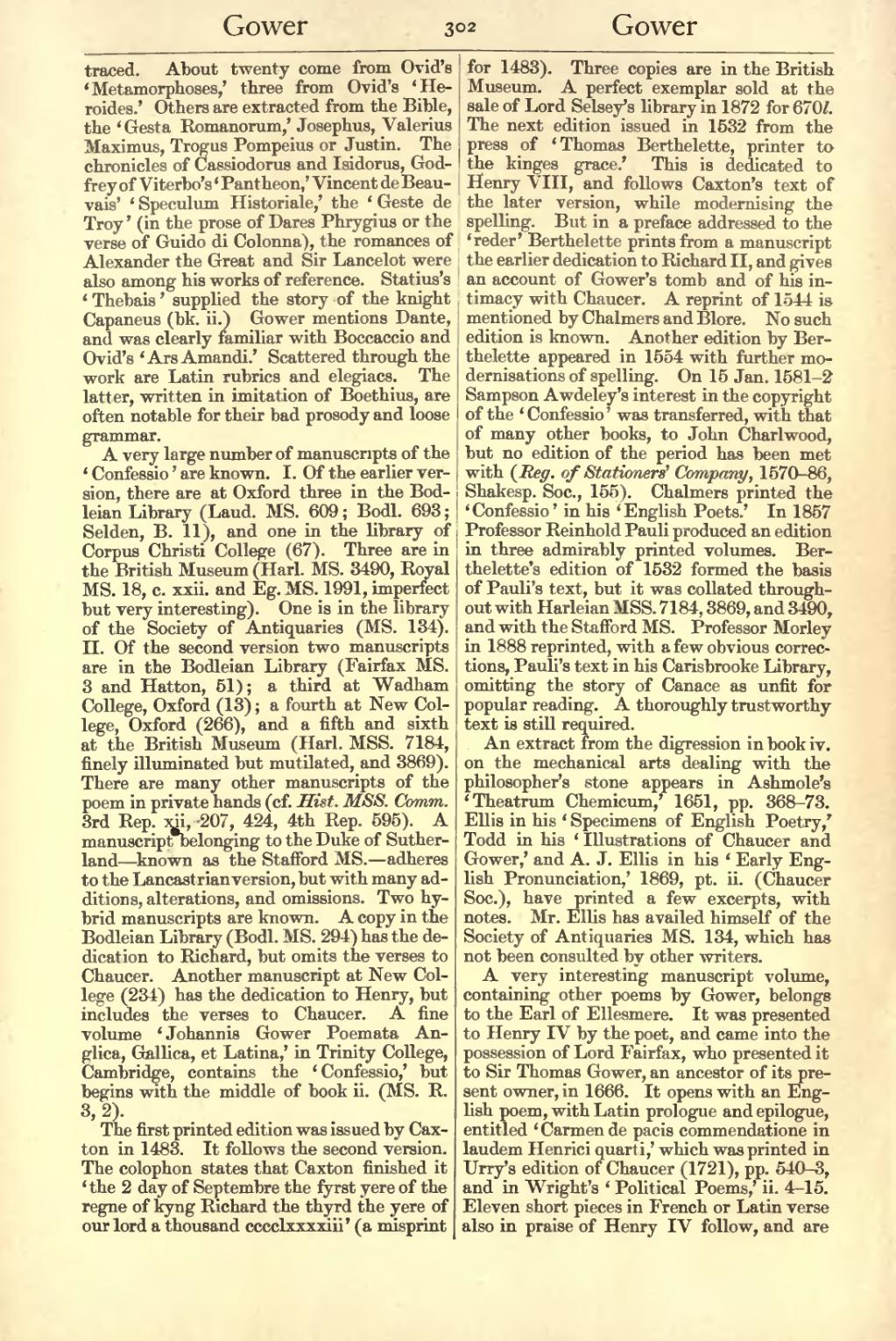traced. About twenty come from Ovid's ‘Metamorphoses,’ three from Ovid's ‘Heroides.’ Others are extracted from the Bible, the ‘Gesta Romanorum,’ Josephus, Valerius Maximus, Trogus Pompeius or Justin. The chronicles of Cassiodorus and Isidorus, Godfrey of Viterbo's ‘Pantheon,’ Vincent de Beauvais' ‘Speculum Historiale,’ the ‘Geste de Troy’ (in the prose of Dares Phrygius or the verse of Guido di Colonna), the romances of Alexander the Great and Sir Lancelot were also among his works of reference. Statius's ‘Thebais’ supplied the story of the knight Capaneus (bk. ii.) Gower mentions Dante, and was clearly familiar with Boccaccio and Ovid's ‘Ars Amandi.’ Scattered through the work are Latin rubrics and elegiacs. The latter, written in imitation of Boethius, are often notable for their bad prosody and loose grammar.
A very large number of manuscripts of the ‘Confessio’ are known. I. Of the earlier version, there are at Oxford three in the Bodleian Library (Laud. MS. 609; Bodl. 693; Selden, B. 11), and one in the library of Corpus Christi College (67). Three are in the British Museum (Harl. MS. 3490, Royal MS. 18, c. xxii. and Eg. MS. 1991, imperfect but very interesting). One is in the library of the Society of Antiquaries (MS. 134). II. Of the second version two manuscripts are in the Bodleian Library (Fairfax MS. 3 and Hatton, 51); a third at Wadham College, Oxford (13); a fourth at New College, Oxford (266), and a fifth and sixth at the British Museum (Harl. MSS. 7184, finely illuminated but mutilated, and 3869). There are many other manuscripts of the poem in private hands (cf. Hist. MSS. Comm. 3rd Rep. xii, 207, 424, 4th Rep. 595). A manuscript belonging to the Duke of Sutherland—known as the Stafford MS.—adheres to the Lancastrian version, but with many additions, alterations, and omissions. Two hybrid manuscripts are known. A copy in the Bodleian Library (Bodl. MS. 294) has the dedication to Richard, but omits the verses to Chaucer. Another manuscript at New College (234) has the dedication to Henry, but includes the verses to Chaucer. A fine volume ‘Johannis Gower Poemata Anglica, Gallica, et Latina,’ in Trinity College, Cambridge, contains the ‘Confessio,’ but begins with the middle of book ii. (MS. R. 3, 2).
The first printed edition was issued by Caxton in 1483. It follows the second version. The colophon states that Caxton finished it ‘the 2 day of Septembre the fyrst yere of the regne of kyng Richard the thyrd the yere of our lord a thousand cccclxxxxiii’ (a misprint for 1483). Three copies are in the British Museum. A perfect exemplar sold at the sale of Lord Selsey's library in 1872 for 670l. The next edition issued in 1532 from the press of ‘Thomas Berthelette, printer to the kinges grace.’ This is dedicated to Henry VIII, and follows Caxton's text of the later version, while modernising the spelling. But in a preface addressed to the ‘reder’ Berthelette prints from a manuscript the earlier dedication to Richard II, and gives an account of Gower's tomb and of his intimacy with Chaucer. A reprint of 1544 is mentioned by Chalmers and Blore. No such edition is known. Another edition by Berthelette appeared in 1554 with further modernisations of spelling. On 15 Jan. 1581–2 Sampson Awdeley's interest in the copyright of the ‘Confessio’ was transferred, with that of many other books, to John Charlwood, but no edition of the period has been met with (Reg. of Stationers' Company, 1570–86, Shakesp. Soc., 155). Chalmers printed the ‘Confessio’ in his ‘English Poets.’ In 1857 Professor Reinhold Pauli produced an edition in three admirably printed volumes. Berthelette's edition of 1532 formed the basis of Pauli's text, but it was collated throughout with Harleian MSS. 7184, 3869, and 3490, and with the Stafford MS. Professor Morley in 1888 reprinted, with a few obvious corrections, Pauli's text in his Carisbrooke Library, omitting the story of Canace as unfit for popular reading. A thoroughly trustworthy text is still required.
An extract from the digression in book iv. on the mechanical arts dealing with the philosopher's stone appears in Ashmole's ‘Theatrum Chemicum,’ 1651, pp. 368–73. Ellis in his ‘Specimens of English Poetry,’ Todd in his ‘Illustrations of Chaucer and Gower,’ and A. J. Ellis in his ‘Early English Pronunciation,’ 1869, pt. ii. (Chaucer Soc.), have printed a few excerpts, with notes. Mr. Ellis has availed himself of the Society of Antiquaries MS. 134, which has not been consulted by other writers.
A very interesting manuscript volume, containing other poems by Gower, belongs to the Earl of Ellesmere. It was presented to Henry IV by the poet, and came into the possession of Lord Fairfax, who presented it to Sir Thomas Gower, an ancestor of its present owner, in 1666. It opens with an English poem, with Latin prologue and epilogue, entitled ‘Carmen de pacis commendatione in laudem Henrici quarti,’ which was printed in Urry's edition of Chaucer (1721), pp. 540–3, and in Wright's ‘Political Poems,’ ii. 4–15. Eleven short pieces in French or Latin verse also in praise of Henry IV follow, and are
